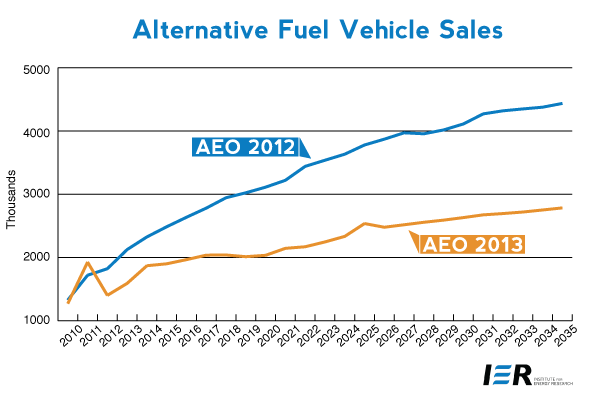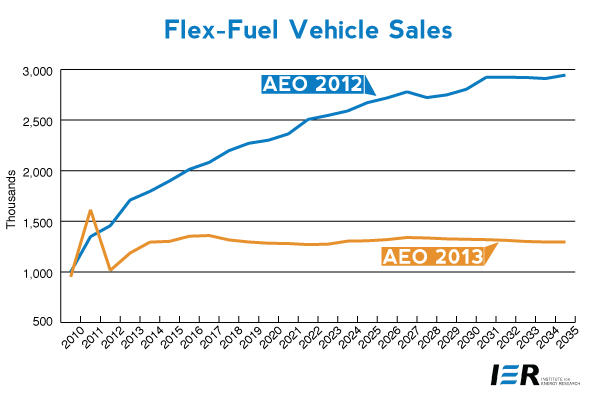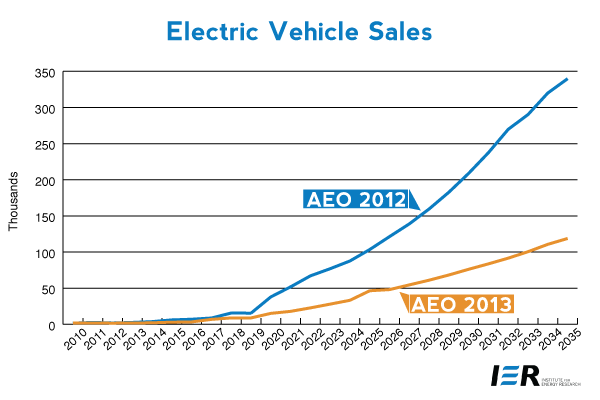In last week’s release of the Annual Energy Outlook 2013, the Energy Information Administration (EIA) took a bold step in lowering its forecast of alternate vehicle sales from its previous forecast.[i] In the Annual Energy Outlook 2013, sales of flex-fuel vehicles in 2035 are less than one-half of the sales of those vehicles projected in the Annual Energy Outlook 2012 and sales of battery-powered electric vehicles in 2035 are 65 percent less. (See graphs below.)
Source: Energy Information Administration, Annual Energy Outlook 2012, Table 39, http://www.eia.gov/forecasts/archive/aeo12/data.cfm#transdemsec and Annual Energy Outlook 2013, Table 57, http://www.eia.gov/forecasts/aeo/er/tables_ref.cfm
Sales of all alternative-fuel vehicles in the Annual Energy Outlook 2013 are lower than in the Annual Energy Outlook 2012 by about 37 percent, or over 1.65 million fewer vehicle sales. (See graph below.) The largest impact is in sales of flex-fuel vehicles, which are about 1.6 million less than the 2.9 million flex fuel vehicles expected to be sold in 2035 in the Annual Energy Outlook 2012 forecast. Sales of battery-powered electric vehicles in the Annual Energy Outlook 2013 total about 119,000 in 2035, compared to almost 340,000 in the previous forecast. Partly offsetting the losses from flex-fuel vehicles and electric vehicles are increased sales of hybrid and plug-in hybrid vehicles, which are about 20 percent higher than the previous forecast reaching about 1.3 million vehicles in 2035.
In the 2040 forecast of the Annual Energy Outlook 2013, less than one percent of all cars sales are all-electric and less than 6 percent of the alternative-fuel vehicle sales are all electric. That’s up from the 2011 market share of less than one-tenth of one percent of the total market with slightly more than 17,000 electric vehicles sold in 2011. Sales of all electric vehicles are limited by continued fuel economy improvement in other vehicle types as well as its unfavorable attributes in terms of vehicle range, trunk space, and cost, particularly regarding batteries.
 Source: Energy Information Administration, Annual Energy Outlook 2012, Table 39, http://www.eia.gov/forecasts/archive/aeo12/data.cfm#transdemsec and Annual Energy Outlook 2013, Table 57, http://www.eia.gov/forecasts/aeo/er/tables_ref.cfm
Source: Energy Information Administration, Annual Energy Outlook 2012, Table 39, http://www.eia.gov/forecasts/archive/aeo12/data.cfm#transdemsec and Annual Energy Outlook 2013, Table 57, http://www.eia.gov/forecasts/aeo/er/tables_ref.cfm
Problems with Electric Vehicles
It is not surprising that the public isn’t clamoring for electric vehicles for the reasons mentioned above. An example of the problems can be seen in Fisker Automotive’s Karma sedan —an electric vehicle costing over $100,000. Consumer Reports recently rated it as the worst luxury sedan and the fourth worst sedan over-all. The Karma broke down at the test facilities before Consumer Reports could even take it for a ride. As Consumer Reports explains:
“With the Karma, much attention has been paid to our unfortunately routine problems, including an early failure on our track that left the car immobile and led to the battery being replaced, frequent instrument, window and radio glitches, and recurring warning lights. So far our Karma has made multiple trips back to the dealer (who, by the way, has provided excellent service, flat-bedding the car to and from our facility).”
Other problems that Consumer Reports found were insufficient seating space, poor visibility, complicated dash controls, lack of accessibility, noisiness, minimal storage, long recharging times and poor assembly with big gaps between indoor components and exterior panels.
Fisker was subsidized $193 million by American tax payers even though it manufactures its cars in Finland. The Department of Energy loan was originally set at $529 million and was to create 2,000 permanent jobs in Delaware, take 30,000 gas-powered cars off the road annually, and lead to 154,000 fewer tons of carbon dioxide emissions per year.[ii] But only the very rich and famous can afford to buy a Karma sedan, according to Consumer Reports.
Electric vehicles have other problems than those we traditionally hear and that are cited above. These vehicles are not very environmentally friendly; from the manufacturing process to produce them, to the electricity used to charge the batteries, to the batteries themselves. The raw materials for the batteries are mined in Canada, refined in China and packaged in Japan. When the batteries run out of their useful life, they have to be disposed as toxic waste.[iii] Further, the electricity needed to power the batteries is predominantly produced from fossil fuels, which negates the reductions in carbon dioxide emissions supporters of electric vehicles argue they are trying to attain. In the United States, between 65 and 70 percent of our electricity is produced from fossil fuels—a share which the EIA expects to remain intact as far out as 2040. In addition to using fossil fuels to power the electricity, the global warming impact of manufacturing electric cars is about twice the comparable impact of conventional vehicles. According to a study by The Norwegian University of Science and Technology, electric car factories emit more toxic waste than conventional car factories.[iv]
Car dealers are now hedging their bets in the electric car arena on more-advanced hybrids, just as EIA is now forecasting. Ford, for example, expects hybrids and electrics to account for up to 25 percent of its sales by 2020 with hybrids making up most of that figure. Toyota has expressed similar views. Hybrids offer consumers more flexibility since they can be filled up at normal gasoline stations and drivers do not need to worry about charging stations and vehicle range.[v]
Conclusion
EIA’s AEO 2013 forecasts show that President Obama’s one million electric cars on the road by 2015 is just a pipe dream with only a few thousand electric vehicles a year being sold between now and then. In fact, according to EIA forecasts, it is not until about 2035, that EIA finds one million electric vehicles on the road. And contrary to arguments that the government must invest in these vehicles in order to compete with the Chinese in this arena, it turns out electric vehicle sales in China are just as anemic. Electric vehicle sales in China during the first 9 months of this year totaled 3009 vehicles with most of them purchased by the government. Electric vehicles are still having problems that confronted electric vehicle manufacturing companies years ago. And, despite taxpayers providing loan guarantees to electric car companies and battery makers, the outlook for electric vehicles is still not good. Handouts from the Obama Administration have helped spur interest in advancing the industry, but the results seem to be just another waste of taxpayer money.
[i] Energy Information Administration, Annual Energy Outlook 2013, Early Release, December 5, 2013, http://www.eia.gov/forecasts/aeo/er/early_consumption.cfm
[ii] National Legal and Policy Center, Consumer Reports: Fisker Karma the Worst Luxury Sedan, September 26, 2012, http://nlpc.org/stories/2012/09/26/consumer-reports-fisker-karma-worst-luxury-sedan
[iii] Driving, Electric vehicle problems still ignored, April 23, 2012, http://www.driving.ca/Electric+vehicle+problems+still+ignored/3814126/story.html
[iv] BBC Business News, Electric cars ‘pose environmental threat’, October 4, 2012, http://www.bbc.co.uk/news/business-19830232
[v] The Motley Fool, The Promise and Problems of Electric Cars, April 22, 2012, http://www.fool.com/investing/general/2012/04/22/the-promise-and-problems-of-electric-cars.aspx





